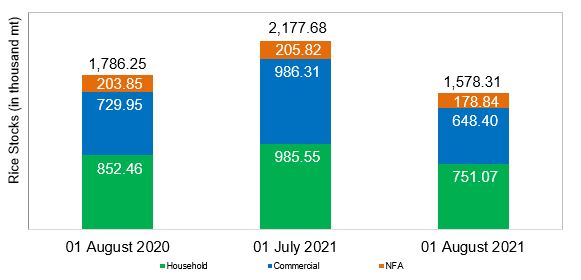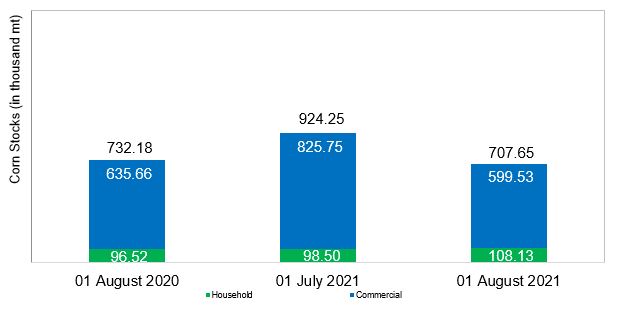Rice and Corn Stocks Inventory, June 2024
RICE
- The 01 August 2021 rice stocks inventory was recorded at 1,587.31 thousand metric tons. This indicates a reduction of -11.6 percent from its level of 1,786.25 thousand metric tons in the same period of the previous year.
- Likewise, rice stocks inventory declined by -27.5 percent compared with the previous month's level of 2,177.68 thousand metric tons. (Figure 1 and Table 1)
- Year-on-year, rice stocks in all sectors contracted compared with their respective levels in the previous year. Stocks in households, commercial warehouses/wholesalers/retailers, and in NFA depositories declined by -11.9 percent, -11.2 percent, and -12.3 percent, respectively.
- Month-on-month, decrements in rice stocks of -23.8 percent, -34.3 percent, and -13.1 percent were noted in households’ stocks inventory, commercial warehouses/wholesalers/retailers, and in NFA depositories, respectively.
- About 47.6 percent of this month’s total rice stocks were from the households, 41.1 percent from commercial warehouses/wholesalers/ retailers, and 11.3 percent from NFA depositories. (Table 1)
Figure 1. Inventory of Rice Stocks, Philippines
August 2020, July 2021, and August 2021


CORN
- As of 01 August 2021, the total corn stocks inventory level was estimated at 707.65 thousand metric tons. This exhibits a decrease of -3.4 percent from the 732.18 thousand metric tons level in the same period of the previous year.
- Similarly, corn stocks dropped by -23.4 percent from the previous month's level of 924.25 thousand metric tons. (Table 2 and Figure 2)
- With reference to the previous year's level, corn household stocks climbed by 12.0 percent. On the other hand, stocks in commercial warehouses/wholesalers/retailers dropped by -5.7 percent.
- In comparison with the previous month's level, corn household stocks rose by 9.8 percent. However, stocks in commercial warehouses/wholesalers/retailers dropped by -27.4 percent.
- Around 15.3 percent of this month's total corn stocks were from the households and 84.7 percent from commercial warehouses/wholesalers/ retailers. (Table 2)
Figure 2. Inventory of Corn Stocks, Philippines
August 2020, July 2021, and August 2021


DENNIS S. MAPA, Ph.D.
Undersecretary
National Statistician and Civil Registrar General
Technical Notes
Monthly rice and corn stocks inventory are generated from three sectors, namely: household, commercial, and government (National Food Authority). The household stocks are taken from the results of Palay and Corn Stocks Survey (PCSS) of the Philippine Statistics Authority (PSA). Effective February 2021, PSA also generates the commercial stocks inventory from the results of Commercial Stocks Survey (CSS) per Implementing Rules and Regulations of Republic Act (RA) No. 11203 known as the “Rice Tariffication Law”. Lastly, the government stocks inventory is taken from administrative records from the National Food Authority.
The PCSS covers sample farming households and non-farming households nationwide. Sample farming households are sub-sample of Palay Production Survey (PPS) and Corn Production Survey (CPS). In these surveys, the primary sampling units (PSUs) are the palay/corn producing barangays and secondary sampling units (SSUs) are the palay/corn farming households. The PSUs are selected using probability proportional to size while the SSUs are selected through systematic sampling. For the non-farming households, five non-farming households are selected for each barangay.
The CSS employs a two-stage systematic sampling wherein the first level of stratification is the line of activity of the NFA registered grains businessmen and the second level of stratification is the businessmen’s capitalization. The line of activity of grains businessmen are stratified into four: 1 - retailers, 2 - wholesalers, 3 - combined retailers/wholesalers, and 4 - warehousemen. The line of activity is further sub-stratified according to businessmen’s capitalization such as 1 - big, 2 – medium, and 3 - small capitalization structure, while warehousemen are sub-stratified into two, namely: 1 - big and 2 - combined medium and small.
